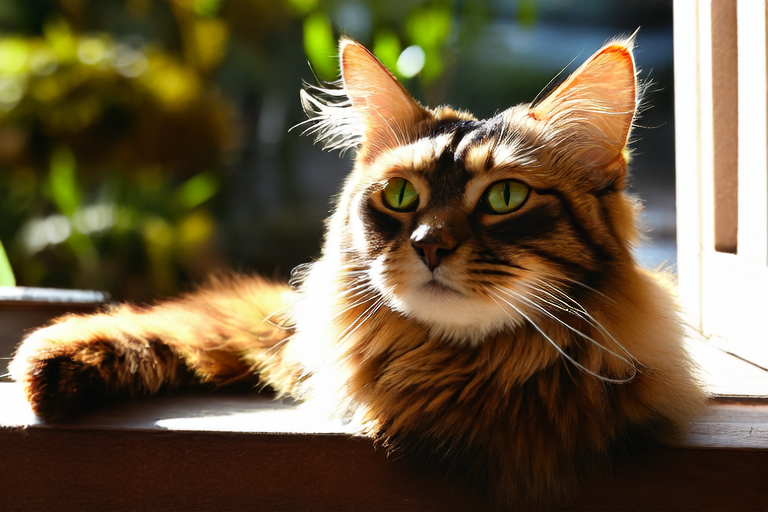Factors Contributing to the Unusually Large Size of Maine Coon Cats
The Maine Coon is one of the largest domesticated cat breeds, known for its impressive size and striking appearance. This breed has captured the hearts of many cat enthusiasts due to its gentle nature and unique physical attributes. The origins of this breed can be traced back to New England, where it was developed as a working cat to assist farmers in controlling rodent populations. Over time, the breed has evolved to become a popular pet around the world. This article explores the genetic, environmental, and historical factors that contribute to the unusually large size of Maine Coon cats, supported by scientific studies and expert opinions.
Genetic Factors
Genetics play a significant role in determining the size of Maine Coon cats. Studies have shown that certain genes are responsible for regulating growth hormone production, which influences body size. A study published in the Journal of Heredity found that specific alleles of the Igf1 gene, which encodes insulin-like growth factor 1, are associated with increased body size in dogs. While similar research has not been conducted specifically on Maine Coon cats, it is reasonable to assume that similar genetic mechanisms may be at work in this breed.
In addition to growth hormone-related genes, other genetic factors may also contribute to the size of Maine Coon cats. For example, some researchers believe that the breed’s large paws and tufted ears may be related to adaptations for living in cold climates. These traits could have been selected for during the breed’s development in New England, where harsh winters required cats to be well-adapted to their environment.
Environmental Factors
The environment in which Maine Coon cats live can also influence their size. One study published in the Journal of Animal Science found that cats raised in enriched environments, such as those with access to outdoor spaces and a variety of toys, were larger than those raised in more restricted environments. This suggests that providing Maine Coon cats with ample space and opportunities for exercise can promote healthy growth.
Another environmental factor that may contribute to the size of Maine Coon cats is nutrition. A well-balanced diet rich in proteins, fats, and essential nutrients is crucial for the healthy development of all cats, including Maine Coons. According to Dr. Lisa Pierson, a veterinarian specializing in feline nutrition, “A high-quality, balanced diet is key to ensuring that Maine Coon cats reach their full potential.” She recommends feeding cats a diet that includes high-quality animal proteins, healthy fats, and essential vitamins and minerals.
Historical Factors
Growth Patterns
Maine Coon cats typically reach their full size between two and four years of age. During this period, they experience rapid growth, with males generally growing larger than females. A study published in the Veterinary Journal found that male Maine Coon cats can weigh up to 18 pounds, while females tend to weigh between 10 and 12 pounds. The growth rate of Maine Coon cats is influenced by a combination of genetic and environmental factors, with proper nutrition playing a critical role in ensuring healthy development.
Comparisons with other cat breeds reveal that Maine Coon cats are significantly larger than most other domesticated cat breeds. For example, the average weight of a domestic shorthair cat is between 7 and 12 pounds, while the average weight of a Siamese cat is between 8 and 15 pounds. In contrast, Maine Coon cats can weigh up to 25 pounds, making them one of the largest domesticated cat breeds.
Myths Surrounding Their Size
Despite their impressive size, there are several myths surrounding Maine Coon cats. One common myth is that they are descended from raccoons, which is not true. Another myth is that they are prone to obesity, but this is not necessarily the case. With proper nutrition and exercise, Maine Coon cats can maintain a healthy weight throughout their lives. It is important to note that overfeeding or feeding a poor-quality diet can lead to obesity in any cat, regardless of breed.
Diet and Health
A well-balanced diet is essential for maintaining the health and wellbeing of Maine Coon cats. As mentioned earlier, a diet rich in high-quality animal proteins, healthy fats, and essential nutrients is recommended. Additionally, Maine Coon cats require regular exercise to maintain a healthy weight and prevent obesity. Providing cats with access to outdoor spaces, interactive toys, and climbing structures can encourage physical activity and promote healthy development.
Regular veterinary check-ups are also important for maintaining the health of Maine Coon cats. These cats are prone to certain health issues, such as hip dysplasia, heart disease, and polycystic kidney disease. Early detection and treatment of these conditions can improve the quality of life for affected cats and extend their lifespan.
In conclusion, the unusually large size of Maine Coon cats is the result of a combination of genetic, environmental, and historical factors. Proper nutrition and exercise are crucial for promoting healthy growth and preventing obesity. By understanding the factors that contribute to the size of Maine Coon cats, we can better appreciate this remarkable breed and ensure that they live long, healthy, and happy lives.
